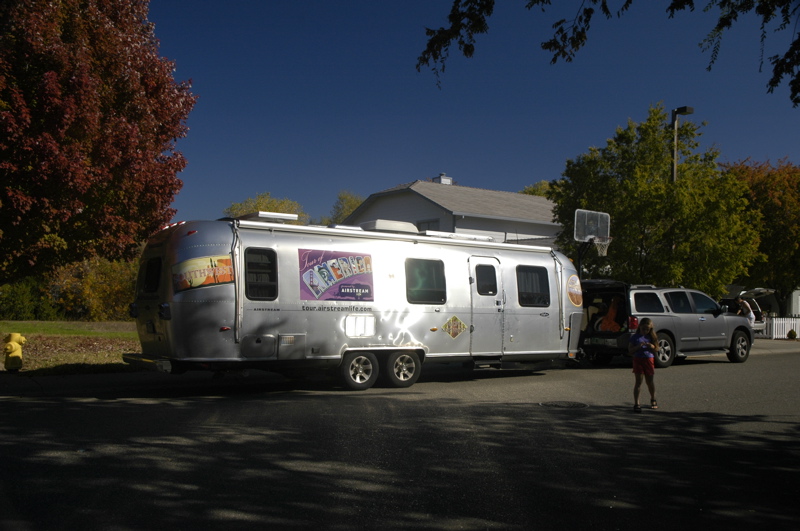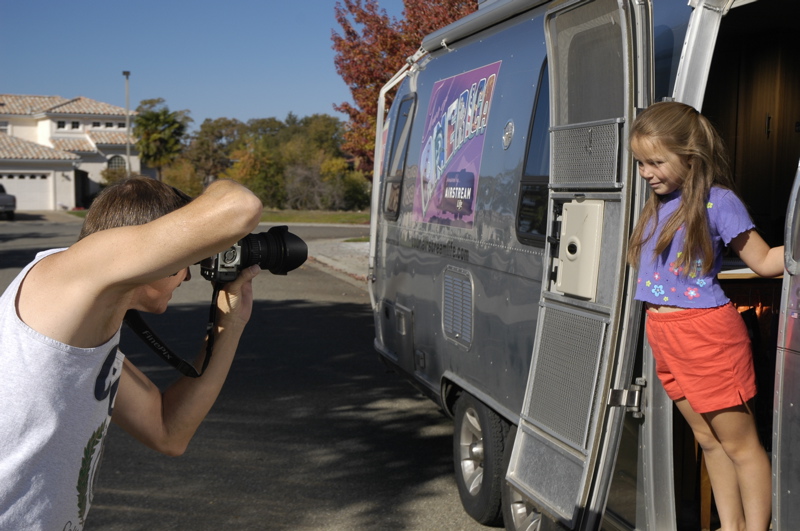It has been a very pleasant Sunday. Our overnight parking spot on the street in front of photographer Doug Keister‘s house turned out to be very quiet. Doug gave us a quick tour of Chico, and then did a little photo shoot of Emma for possible inclusion in one of his future projects. By 11:30, we were shoving off and moving south on Rt 99 again, toward tonight’s courtesy parking spot in Amador City, CA.
Courtesy parking is one of our favorite modes of “camping.” When you park at someone’s house, you often get the benefit of a fun visit and great insider tips about the local area. Since we’ve been in campgrounds a lot lately, I’ve been looking forward to a few nights of courtesy parking. It makes a nice balance, in addition to saving money.
But campgrounds still constitute the bulk of our nights on the road, so it pays to have a solid understanding of what to look for in a campground. I know from talking to other RV travelers that there is a lot of confusion about this. I’ve rarely talked about the differences between campgrounds, but perhaps it’s time. Campgrounds are not all made equal.
With time, you can develop a sense of what sort of camping experience you’ll get just by looking at the entrance to a campground, or from reading its description in a guide. If we want a scenic, natural, and peaceful experience above all, we tend to avoid places with hundreds of sites, those that are visible from the Interstate, and those with high percentages of permanent residents. Often just the appearance of the entry gate or sign will give a solid clue to the experience that awaits within.
Terms in guidebooks like “big rig friendly,” “laundry, store, and pool,” and “all pull-throughs” are hints that the campground will offer convenience but probably not natural settings. It’s up to you to decide what you want that night. We vacillate between seeking convenience and connectivity (cell phone, Internet), and solitude and natural beauty. In some cases we can find both, but more often a compromise has to be made. My general rule of thumb is that desirability of a spot is inversely proportional to the likelihood of getting online. When we do find a place that offers it all, we stay longer.
There are other clues as well. For example, campgrounds that participate heavily in deep-discount membership programs are generally not in highly desirable locations, but there are exceptions. Most often we find they are at the edge of town or a bit run down. Still, if you’re a member of Passport America, Happy Camper, or other similar programs, the discount often makes up for the minor deficiencies of the campground.
State parks are almost always pleasant but you need to understand each state to know what to expect. In Florida, for example, all state parks with camping have 30-amp electric. In Vermont, none do. Older state parks built during the CCC era (1930s) generally have narrower roads and smaller sites, but nicer settings, so an abundance of CCC-type architecture (stone walls for example) is a clue.
Campgrounds that are predominantly mobile home parks are almost always best avoided. While the sign may say “RV’s welcome”, we’ve never seen one that we’d want to spend money to stay in. However, a lot of RV parks have a small area of fixed or mobile homes off to the side, and those are usually fine.
“55+” is a glaring clue. Since we aren’t over 55 years old, and we travel with a child, we regard “55+” as a sign that the park is filled with stodgy people who have lost their appreciation of children. I appreciate the warning. We’ll go somewhere else. (It’s a shame that these discriminatory “55+” parks are such a plague in Arizona and Florida, however.)
National Forest Service campgrounds, Bureau of Land Management campgrounds, and Corps of Engineers campgrounds can be found in some really spectacular natural areas, and they’re usually cheap. They tend to be in the boondocks. Finding one near where you want to be can be tricky, but if there’s one nearby, they are often pleasantly surprising.
If you’re the sort of person who likes to eat at chain restaurants everywhere you go because you know what to expect, you’ll love big camping chains like KOA. But if you’re the adventuresome type that likes to try the local food wherever you go, you’ll soon learn the subtle cues that lead you to the type of stay you want.
Tonight we are parked at Rob & Sadie’s house in the tiny gold-mining town of Amador City CA. Since we’ll be here two nights, I’ll tell you all about it tomorrow.




November 9th, 2007 at 11:58 am
Rich,
Great lines on campground inequalities. We spent too many nights in campgrounds inadvisably proximate to Interstates. These ranged from $18.00 to $40.00, and the descriptions sometimes incorrectly stated, “very quiet”. Our selection criteria was at fault. The latter part of our trip was graced by many state parks and more remote private campgrounds, sometimes up to ten miles away from the Interstate. And worth every mile! You hit the nail on the head with your comment on balancing convenience and beauty. Once we decided and acted on what we valued we were happier with our choices.
Jim